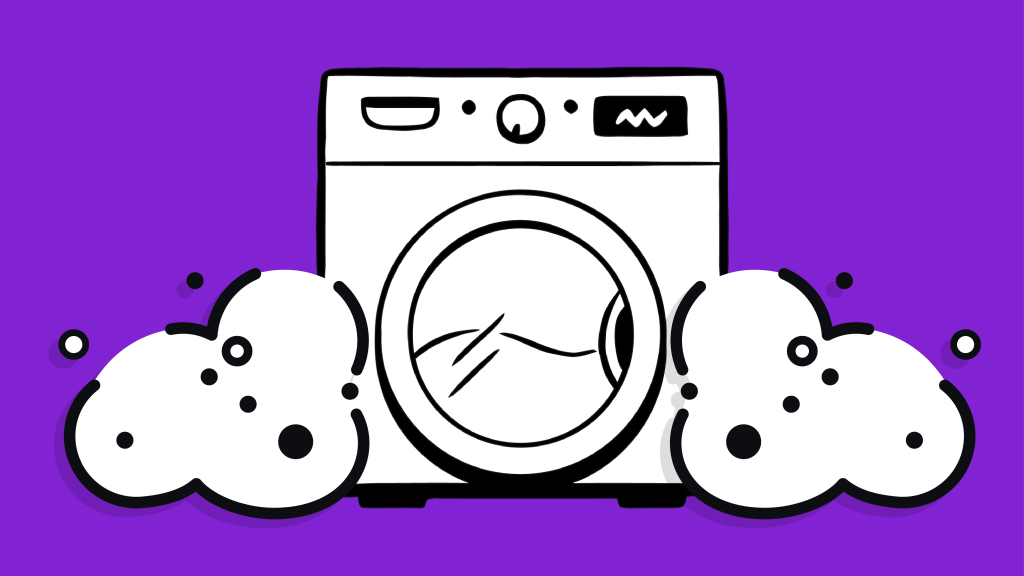Most of us know that it’s important to clean your dryer lint filter every time you dry a load. But did you know there could be lots of lint in your washing machine, too? Don’t worry. We’ll explain. Asurion Experts help people care for all their tech, including their appliances. Whether your washer won’t spin or you want to clean a front-load washer, we’ll share our best tips. Here’s our guide on how to get lint out of a washing machine.
Why do washers have lint filters?
Where there are clothes, there’s lint. Lint usually collects in the dryer, but if it collects in your washer—and that happens frequently—it can build up, clog your filter, and keep your appliance from working its best. If you don’t remove it, lint can seriously damage your washing machine.
Signs your washer lint filter might be clogged
Here are a few signs your washing machine lint filter may be clogged:
- Your washer smells bad.
- You see lint on clothes you just washed.
- Your machine isn’t draining properly.
How often should you clean the lint filter?
Our experts recommend cleaning your washing machine lint filter every three months. If you use your washer daily or your laundry includes heavily soiled items like baby clothes or pet blankets, consider cleaning your filter once a month.

Psst... Got 2 minutes?
That’s how long it takes to get a care plan personalized for you:
✓ Coverage for thousands of devices ✓ Fast, quality fixes
✓ Hands-on help when you need it
How to clean your washer lint filter
Ready to remove the lint from your washing machine? Unplug your washer. Then, depending on what type of washer you have, here’s what to do next:
Top-loading washing machine
- Locate the lint filter. In most top-loaders, the lint filter is either positioned along the top rim of the washer drum or at the end of the drainage hose. You may also find it inside the center agitator, which you can unscrew and remove. Check your owner’s manual if you need help.
- Remove the filter. If the filter is on the top rim, lift it straight up and out of the slot. If the filter is located at the end of a drainage hose, you may need to disconnect the hose first to access the filter.
- Clean the filter.
- Rinse the filter under running water to remove any lint and debris.
- For stubborn lint or residue, use a soft brush (like a clean toothbrush) and a 50/50 mixture of water and white vinegar to gently scrub the filter.
- If the filter smells or you see other buildup, soak it in a solution of hot water and mild detergent for 5 minutes, then rinse thoroughly.
- Reinsert the filter. Place the clean filter back into its slot and reattach the drainage hose if needed. Make sure the filter and hose are securely in place so it won’t leak.
- Run a rinse cycle. Run your washer on a rinse cycle with no clothes in it to clear out any remaining lint or detergent.
Front-loading washing machine
- Find the lint filter. The lint filter in front-loading machines is typically located near the lower front of the washer, behind a small hatch or door. Check your owner’s manual if you’re having trouble.
- Prepare for water. Place a towel or a pan under the hatch to collect any water that may spill out when you open the filter.
- Open the hatch. You may need to twist a dial, pull a tab, or use a small tool to open the hatch and access the filter.
- Clean the filter.
- Gently pull the filter to remove it.
- Rinse the filter under running water to remove lint, debris.
- Use a small soft brush or cloth to scrub away any build-up from detergent or fabric softener.
- If the filter is extra dirty, soak it in warm soapy water for 5 minutes.
- Rinse thoroughly.
- Check the filter housing. Inspect the housing for any debris or lint that may have come loose.
- Reinsert the filter. Slide the filter back into its slot. Make sure it’s fastened securely.
- Close the hatch. Secure the hatch or door.
- Turn on the rinse cycle. Plug your washer back in and run a short rinse cycle to remove any leftover soap residue.
High-efficiency washers
High-efficiency washers don’t have lint traps. To keep your washing machine working its best, run it on its cleaning cycle once a month.
Want to keep on cleaning? Check out our guide on how to clean a front-load washer.
Reliable protection for the major appliances you rely on
When your appliances don't work, we do. With Asurion Appliance+®, you get hassle-free coverage and 24/7 troubleshooting support for your current and future appliances—no matter the brand or where you bought them. But it’s not the only care plan we offer. Take our 2-minute quiz to find the right care plan for your appliances and tech, or learn more about how you can get total peace of mind with Asurion Appliance+.

